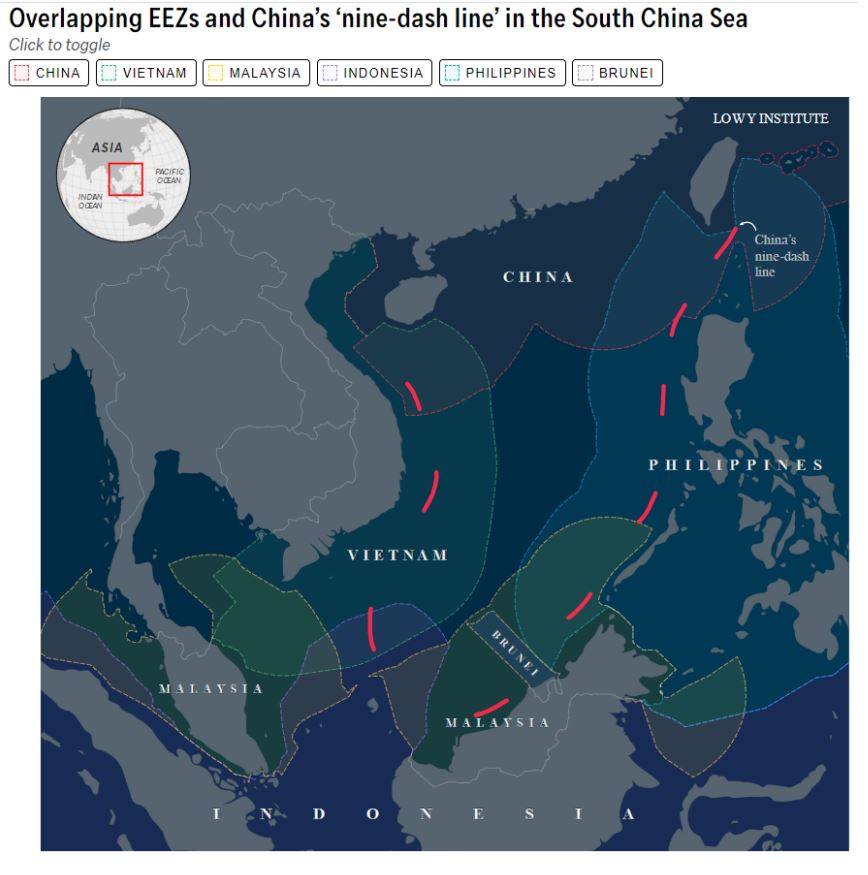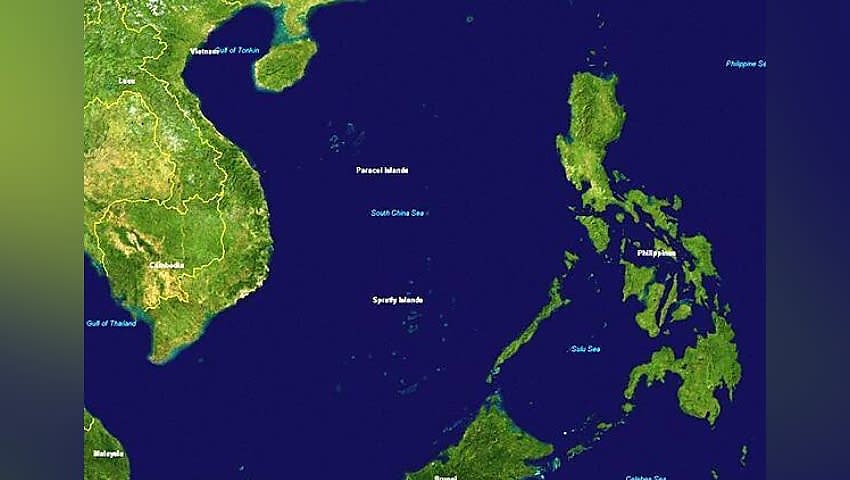The Spratly Islands archipelago may appear to be tiny specks on the world map, but it arguably contains one of the most contested parcels of land in recent history.
Over 100 small islands make-up the cluster of nonarable land that equate to a total of about two-kilometres, which cannot offer a viable supply of drinkable water. Yet, the islands have been part of an ongoing dispute between China, Taiwan, Vietnam, Malaysia, Brunei and the Philippines for decades due to the Spratly's geographic position on strategic waterways near several primary shipping lanes.
As China seeks effective control of the sea, tensions between the south-east Asian states have increased over the status and "ownership" of the small archipelago. According to Malcolm Cook at the Lowy Institute, China has violated the maritime and sovereign rights of the surrounding five south-east Asian littoral states by aggressively pushing its unlawful "nine-dash line" maritime claims.

Consider China's outright rejection of the United Nations Convention on the Law of the Sea (UNCLOS) arbitral tribunal ruling that upheld the Philippine case against it in 2016.
After China’s forceful assertion of control over the Scarborough Shoal in the Philippine exclusive economic zone in the South China Sea in 2012, followed by its artificial island-building campaign in the Spratlys in 2013, among a string of violations against Philippine sovereign and maritime rights, it further clarified its approach. The Philippines was compelled to institute arbitral proceedings against China under UNCLOS as a result.
Australia called on the Philippines and China to abide by the UNCLOS ruling, and the opposing position has been a significant factor in the deteriorating Australia-China relations. As Cook’s Lowy Institute paper, titled Australia’s South China Sea Challenges, has found, China’s belligerent response and the way it has handled its disputes with five south-east Asian littoral states has revealed its lack of willingness to accept the current rules-based order.
There are two looming challenges to Australia’s South China Sea policies according to Cook. A possible Code of Conduct in the South China Sea between ASEAN and China (COC) and the likelihood of increased US pressure on Australia to conduct Freedom of Navigation Operations (FONOPs) within 12 nautical miles of Chinese-claimed features in the areas covered by the UNCLOS ruling.
There is a low-probability of China agreeing to a South China Sea Code of Conduct (COC) that is consistent with the 2016 South China Sea arbitral tribunal ruling. Any COC that China agrees with the Association of southeast Asian Nations (ASEAN) will harm Australia’s interests, but a lack of Australian support for such a code would aggravate relations with south-east Asian states, ASEAN, and with China, Cook predicts.
So far, the south-east Asian littoral states have reacted unevenly, exclusively seeking to defend their sovereign and maritime rights from China’s unlawful claims individually and through ASEAN.
Nonetheless, since the Philippines filed its arbitration case against China under UNCLOS in January 2013, the US has challenged China’s excessive claims in the South China Sea with more frequent and public FONOPs. In response, China has accused the US of further militarising its artificial islands.
Under UNCLOS, features like the artificial islands that China has developed have no territorial seas of their own. The US has been exercising its freedom of navigation and overflight rights in the South China Sea to contest China’s unlawful claims and offer support to the south-east Asian littoral states following the UNCLOS ruling. The Trump administration saw the operations increase in frequency.
To date, Australia has not engaged in FONOPs despite a push from both the Obama and Trump administrations, but Cook concludes the Biden administration is likely to increase pressure on Australia to begin conducting FONOPs in the South China Sea in the coming years.
After the G7 recently expressed “serious concern” about the situation in the East and South China Seas by declaring a strong opposition to any unilateral attempts to change the status quo in the region outlined in the summit communique, Chinese Foreign Ministry spokesman Zhao Lijian responded by asserting “the era of one country or a bloc of countries dictating world affairs is over”, to communicate China’s firm opposition and strong dissatisfaction over the G7’s collective stance at his regular press conference.
As Michael Shoebridge at ASPI suggests, President Xi Jinping’s China should be viewed as a multilateral, strategic, technological and economic challenge. After pushing back against coercive practices by passing new laws to reduce the impact of China's covert interference in politics and policymaking, to finding ways for multilateral groupings to hold China to account against all the commitments it has made, investing in contributing to credible military deterrence as detailed in last year’s defence strategic update, Australia has found itself leading the global China debate.
With NATO declaring its view that China has posed “systemic challenges” to international order and reports the US is considering making moves to establish a permanent naval task force in the Asia-Pacific region to counter China’s escalating aggression, Australia has found that it is not alone in dealing with China following the G7 summit that condemned the autocratic nation’s “practices which undermine”.
But, the question remains, will the mounting pressure against China curb its advances towards a much broader scope, well past the Spratley Islands?
[Related: Acts of war in space included in NATO defence clause]









